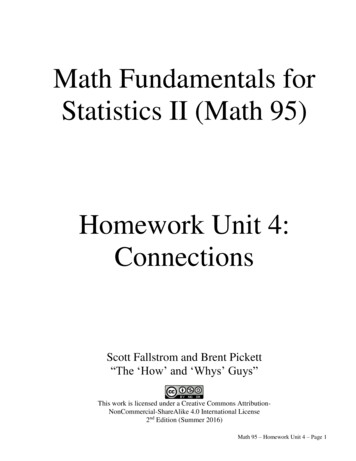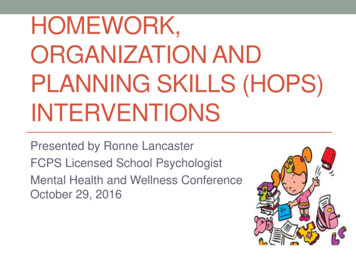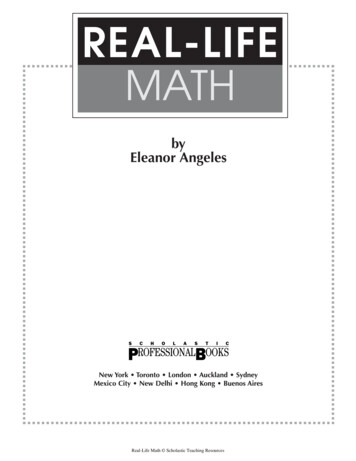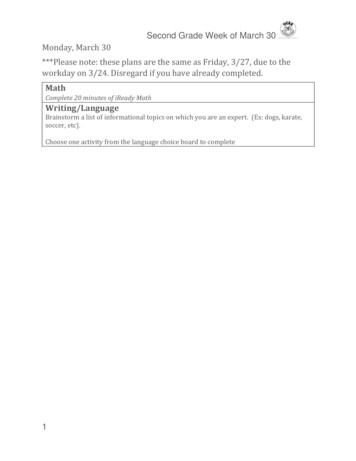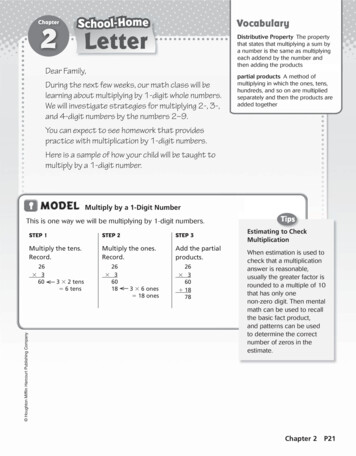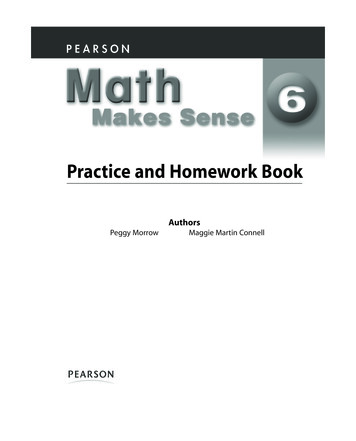
Transcription
FM-PH-Math6 SE6/18/0910:05 AMPage iPractice and Homework BookAuthorsPeggy MorrowMaggie Martin Connell
FM-PH-Math6 SE6/18/0910:05 AMPage iiPublisherMike CzukarPublishing TeamClaire BurnettJon MaxfieldBronwyn EnrightEllen DavidsonCheri WestraJane SchellKaren AlleyJudy WilsonResearch and Communications ManagerBarbara VogtDesignWord & Image Design Studio Inc.TypesettingComputer Composition of Canada Inc.Copyright 2010 Pearson Canada Inc., Toronto, Ontario.All Rights Reserved. This publication is protected bycopyright, and permission should be obtained fromthe publisher prior to any prohibited reproduction,storage in a retrieval system, or transmission in anyform or by any means, electronic, mechanical,photocopying, recording, or likewise. Forinformation regarding permission, write to thePermissions Department.ISBN-13: 978-0-321-49645-4ISBN-10:0-321-49645-0Printed and bound in Canada.1 2 3 4 5 -- WC -- 13 12 11 10 09
FM-PH-Math6 SE6/18/0910:05 AMPage iiiContentsUNIT1Patterns and Equations . . . . . . . . . . . . . . . . . 2Lesson 1Lesson 2Lesson 4Lesson 5Lesson 6Lesson 7Lesson 8UNIT2UNIT3Lesson 1Lesson 2Lesson 3Lesson 4Lesson 5Lesson 7Lesson 8Lesson 9Lesson 1Lesson 2Lesson 3Lesson 4Lesson 5Lesson 7Lesson 8Mixed Numbers . . . . . . . . . . . . . . . . . . . 58Converting between MixedNumbers and Improper Fractions . . 60Comparing Mixed Numbers andImproper Fractions . . . . . . . . . . . . . . . . 62Exploring Ratios . . . . . . . . . . . . . . . . . . . 64Equivalent Ratios . . . . . . . . . . . . . . . . . . 66Exploring Percents . . . . . . . . . . . . . . . . . 68Relating Fractions, Decimals,and Percents . . . . . . . . . . . . . . . . . . . . . . 70Exploring Large Numbers . . . . . . . . . . 16Numbers All Around Us . . . . . . . . . . . . 18Exploring Multiples . . . . . . . . . . . . . . . . 20Prime and Composite Numbers . . . . 22Investigating Factors . . . . . . . . . . . . . . . 24Order of Operations . . . . . . . . . . . . . . . 26What Is an Integer? . . . . . . . . . . . . . . . . 28Comparing and OrderingIntegers . . . . . . . . . . . . . . . . . . . . . . . . . . . 30UNIT6Geometry and Measurement . . . . . . . . . . 72Lesson 1Lesson 2Lesson 3Lesson 4Lesson 5Lesson 7Lesson 8Lesson 9Exploring Triangles . . . . . . . . . . . . . . . . 72Naming and Sorting Trianglesby Angles . . . . . . . . . . . . . . . . . . . . . . . . . 74Drawing Triangles . . . . . . . . . . . . . . . . . 76Investigating Polygons . . . . . . . . . . . . . 78Congruence in Regular Polygons . . . 80Perimeters of Polygons . . . . . . . . . . . . 82Area of a Rectangle . . . . . . . . . . . . . . . . 84Volume of a Rectangular Prism . . . . . 86Decimals . . . . . . . . . . . . . . . . . . . . . . . . . . . . . 32Lesson 1Lesson 3Lesson 4Lesson 5Lesson 6Lesson 745Fractions, Ratios, and Percents . . . . . . . . . 58Understanding Number . . . . . . . . . . . . . . . 16Lesson 2UNITInput/Output Machines . . . . . . . . . . . . . 2Patterns from Tables . . . . . . . . . . . . . . . . 4Using Variables to DescribePatterns . . . . . . . . . . . . . . . . . . . . . . . . . . . . 6Plotting Points on a CoordinateGrid . . . . . . . . . . . . . . . . . . . . . . . . . . . . . . . . 8Drawing the Graph of a Pattern . . . . 10Understanding Equality . . . . . . . . . . . . 12Keeping Equations Balanced . . . . . . . 14UNITNumbers to Thousandthsand Beyond . . . . . . . . . . . . . . . . . . . . . . . 32Estimating Products andQuotients . . . . . . . . . . . . . . . . . . . . . . . . . 34Multiplying Decimals by aWhole Number . . . . . . . . . . . . . . . . . . . . 36Multiplying a Decimal Lessthan 1 by a Whole Number . . . . . . . . . 38Dividing Decimals by a WholeNumber . . . . . . . . . . . . . . . . . . . . . . . . . . . 40Dividing Decimals . . . . . . . . . . . . . . . . . 42Dividing a Decimal Less than 1by a Whole Number . . . . . . . . . . . . . . . 44Angles and Polygons . . . . . . . . . . . . . . . . . . 46Lesson 1Lesson 2Lesson 3Lesson 4Lesson 6Lesson 7Naming Angles . . . . . . . . . . . . . . . . . . . . 46Exploring Angles . . . . . . . . . . . . . . . . . . 48Measuring Angles . . . . . . . . . . . . . . . . . 50Drawing Angles . . . . . . . . . . . . . . . . . . . 52Investigating Angles in a Triangle . . 54Investigating Angles in aQuadrilateral . . . . . . . . . . . . . . . . . . . . . . 56UNIT7Data Analysis and Probability. . . . . . . . . . 88Lesson 1Lesson 2Lesson 3Lesson 4Lesson 5Lesson 6Lesson 7UNIT8Using a Questionnaire to GatherData . . . . . . . . . . . . . . . . . . . . . . . . . . . . . . . 88Conducting Experiments to GatherData . . . . . . . . . . . . . . . . . . . . . . . . . . . . . . . 90Interpreting Graphs . . . . . . . . . . . . . . . . 92Drawing Graphs . . . . . . . . . . . . . . . . . . . 94Choosing an Appropriate Graph . . . 96Theoretical Probability . . . . . . . . . . . . . 98Experimental Probability . . . . . . . . . 100Transformations . . . . . . . . . . . . . . . . . . . . . 102Lesson 1Lesson 2Lesson 3Lesson 4Lesson 5Drawing Shapes on a CoordinateGrid . . . . . . . . . . . . . . . . . . . . . . . . . . . . . .102Transformations on a CoordinateGrid . . . . . . . . . . . . . . . . . . . . . . . . . . . . . .104Successive Transformations . . . . . . .106Combining Transformations . . . . . . .108Creating Designs . . . . . . . . . . . . . . . . . .110Math at Home . . . . . . . . . . . . . . . . . . . . . . . 113iii
FM-PH-Math6 SE6/18/0910:06 AMPage ivTo the TeacherThis Practice and Homework Book provides reinforcement of the concepts and skillsexplored in the Pearson Math Makes Sense 6 program.There are two sections in the book. The first section follows the sequence of Math MakesSense 6 Student Book. It is intended for use throughout the year as you teach the program.A two-page spread supports the content of each core lesson in the Student Book.In each Lesson:Quick Review summarizesthe math concepts andterminology of the StudentBook lesson.Try These presentsquestions the student canuse to check understandingof the math concepts andskills in each lesson.The right page is the“homework” page, to becompleted by the studentwith the assistance of afamily member.Stretch Your Thinkingpresents an extensionquestion.Math at HomeThe second section of the book, on pages 113 to 124, consists of 3 pull-out Math at Homemagazines. These fun pages contain intriguing activities, puzzles, rhymes, and games toencourage home involvement. The perforated design lets you remove, fold, and send homethis eight-page magazine after the student has completed units 3, 6, and 8.iv
FM-PH-Math6 SE6/18/0910:06 AMPage vTo the FamilyThis book will help your child practise the math concepts and skills thathave been explored in the classroom. As you assist your child to completeeach page, you have an opportunity to become involved in your child’smathematical learning.The left page of each lesson contains a summary of the main concepts andterminology of the lesson. Use this page with your child to review the workdone in class. The right page contains practice.Here are some ways you can help: With your child, read over the Quick Review. Encourage your child totalk about the content and explain it to you in his or her own words. Read the instructions with (or for) your child to ensure your childunderstands what to do. Encourage your child to explain his or her thinking. Some of the pages require specific materials. You may wish to gatheritems such as a centimetre ruler, index cards, a measuring tape,scissors, cubes numbered from 1 to 6, and paper clips.Many of the Practice sections contain games that will also improve yourchild’s math skills. You may have other ideas for activities your child canshare with the rest of the class.The Math at Home pull-out pages 113 to 124 provide more fun activities.v
Unit01-PH-Math6 SE6/18/098:46 AMPage 2TUTD E N B OO1KSUNIT 1Input/Output MachinesLESSO NQuick ReviewThe pattern rule forthe output is:Start at 9. Add 9 each time.InputOutput19218327436545 Try These1. Complete the table of values for each Input/Output 2011 Output16 2. Look at the tables of values in question 1. Write the pattern rule for eachgroup of terms.a) the output numbers in part a)b) the input numbers in part b)2lhooThis is an Input/Output machine.It can be used to make a growing pattern.Each input is multiplied by 9 to get theoutput.If you input 1, the output is 9.If you input 2, the output is 18.meAt ScAt Ho
Unit01-PH-Math6 SE6/18/098:46 AMPage 3Practice1. Complete the table of values for each Input/Output machine.a)b)InputOutputInput9330590310873158432081 Output325 2. Look at the tables of values. Write the number and the operation in 38293777203638494Input68034 Output47611 Stretch Your ThinkingThe table of values shows theInputOutputInput/Output from a machine.34561152a) Write the number and operation35311177for the machine.36061202b) Write the pattern rule for the input36811227numbers.37561252 c) Write the pattern rule for the outputnumbers.3
Unit01-PH-Math6 SE6/18/098:46 AMPage 4TUTD E N B OO2Patterns from TablesKSUNIT 1LESSO NQuick ReviewmeAt ScAt HoThis Input/Output machine divideseach input by 2, then adds 3. 2The pattern rule that relates the inputto the output is: Divide the inputby 2. Then add 3.We can use this rule to predict theoutput for any input.For an input of 70, the output is:70 ! 2 3 38lhoo 3InputOutput20133018402350286033Try These1. Each table of values shows the input and output from a machine with1 operation. Write the number and the operation in each 8161231020822. Write the pattern rule that relates the input to the output for each table ofvalues in question 1.a)b)4
Unit01-PH-Math6 SE6/18/098:46 AMPage 5Practice1. Each table shows the input and output froma machine with 2 operations.For each table, write the numbers and the operations in the 502072653255228286396024930746652610322. Write the pattern rule that relates the input to the output for each table inquestion 1.a)b)c)3. This table shows the input and output from a machine with 2 operations.a) Write the numbers and the operationsin the machine.InputOutput251530183521b) Write the next 3 input and outputnumbers.c) Predict the output when the input is 100.Stretch Your ThinkingThe first 5 input numbers for the machine are:2527, 2577, 2627, 2677, and 2727.The first 5 output numbers for the machine are:5061, 5161, 5261, 5361, and 5461.Write the numbers and the operations in the machine.5
Unit01-PH-Math6 SE6/18/09TUTD E N B OO4KSUNIT 18:46 AMPage 6Using Variables toDescribe PatternsLESSO NQuick ReviewmeAt ScAt HoThe pattern rule for the output is:Start at 5. Add 2 each time.This suggests the input numbers aremultiplied by 2.Multiply input 3 by 2: 3 " 2 6To get output 9, add 3.The pattern rule that relates the input tothe output is: Multiply by 2. Then add 3.We can use a variable in an expression torepresent this rule.Let the letter n represent any inputnumber.Then, the expression 2n 3 relates theinput to the output.InputOutput152739411513InputOutput12"1 3 522"2 3 732"3 3 942 " 4 3 1152 " 5 3 13n2"n 3lhooTry These1. Complete each table of values, then write an expression that relates theinput to the 67Output914192429c)Input012345Output410162228
Unit01-PH-Math6 SE6/18/098:46 AMPage 7Practice1. Here is a pattern of triangles.Figure 1Figure 2a) Complete the table.b) Write the pattern rule.Figure 3Figure1234c) Write an expression for the pattern.Figure 4Number of Trianglesd) Find the number of triangles in the8th figure.2. For each table of values, write an expression to represent the 419Stretch Your Thinkinga) Use the expression 7n 10 to completethe table.b) Write and solve a story problem thatmatches the pattern.Number01234Amount ( )7
Unit01-PH-Math6 SE6/18/09TUTD E N B OO5KSUNIT 18:46 AMPage 8Plotting Points on aCoordinate GridLESSO NQuick ReviewVertical axis10The coordinates of point A are (5, 7).8A6420The origin is the point where the2 4 6 8 10Horizontal axishorizontal and vertical axes meet.In an ordered pair: The first number tells the horizontal distance from the origin. The second number tells the vertical distance from the origin. The coordinates of point B are (3, 2).To plot point B:Start at 0, move 3 squares right, thenmove 2 squares up.Vertical axis10864B202 4 6 8 10Horizontal axisTry These1. a) Name the letter on thegrid represented by eachordered pair.(6, 7)(1, 4)(9, 6)(7, 2)(3, 8)b) Plot each point on the grid.J(0, 2), K(8, 1), L(10, 4)8A8Vertical axis(2, 5)10DF64ECB202468Horizontal axis10lhoo We use an ordered pair to describethe coordinates of a point on a grid.G(5, 4), H(10, 10), I(0, 9),meAt ScAt Ho
Unit01-PH-Math6 SE6/18/098:46 AMPage 9Practice108Vertical axis1. Plot each set of ordered pairs onthe coordinate grid.Join the points in order.Join the last point to the first point.Name each polygon you have drawn.A: (8, 6), (6, 6), (6, 8), (8, 8)6420B: (0, 3), (4, 0), (6, 0), (2, 3)246810Horizontal axisC: (1, 6), (1, 10), (4, 10), (4, 6)D: (7, 1), (6, 3), (8, 5), (10, 3), (9, 1)A:B:C:D:108Vertical axis2. Plot 6 points on the grid.Label the points A to F.Record the ordered pairs.6420246810Horizontal axisE:F:Stretch Your Thinking10Vertical axis(2, 5) and (7, 5) are 2 vertices of aparallelogram with area 10 square units.Plot the points for the 2 given vertices.What are the coordinates of the other vertices?Give as many answers as you can.864202 4 6 8 10Horizontal axis9
Unit01-PH-Math6 SE6/18/098:46 AMTUTD E N B OO6KSUNIT 1Page 10Drawing the Graphof a PatternLESSO NQuick ReviewFigure 2Figure 3Figure 4 Draw a graph.FigureNumberNumber of SquaresOrderedPair15(1, 5)26(2, 6)37(3, 7)48(4, 8)Number of Squares Make a table.Number of Squaresin a Pattern10864202 4 6 8 10Figure NumberTry These1. Henry made this pattern.Figure 1Figure 210Figure 4b) Graph the patternFigureNumberNumber of SquaresOrderedPair12(1, 2)Number of Squaresa) Complete the table.Figure 3Number of Squaresin a Pattern1086420 2 4 6 8 10Figure NumberlhooHere are some ways to represent a pattern. Model the pattern on grid paper.Figure 1meAt ScAt Ho
Unit01-PH-Math6 SE6/18/098:46 AMPage 11Practice1. a) Describe the relationship shownin the table.Figure Number1 2 3 4 5Number of Squares 1 3 5 7 9b) Draw squares on the grid to model the pattern.c) Graph the pattern.e) Which figure has 29 squares?f) Which figure has 51 squares?10Number of Squaresd) How many squares are needed forFigure 10?Number of Squaresin a Pattern86420246810Figure Number2. Draw a pattern to modelthe data in the table.Figure Number1 2 3 4Number of Triangles1 2 4 8Stretch Your ThinkingUse the table in question 2.How many triangles are in Figure 10?Which figure has 8192 triangles?11
Unit01-PH-Math6 SE6/18/098:46 AMPage 12TUTD E N B OO7KSUNIT 1Understanding EqualityLESSO NQuick ReviewmeAt ScAt Holhoo Each of these scales is balanced.The expression in one pan is equal to the expression in the other pan.48 856 3048 ! 8 6 and2"3 6So, 48 ! 8 2 " 32 3100 – 1456 30 86 and100 – 14 86So, 56 30 100 – 14 When we add 2 numbers, their order does not affect the sum.This is called the commutative property of addition.7 5 5 7a b b a When we multiply 2 numbers, their order does not affect the product.This is called the commutative property of multiplication.6"3 3"6a"b b"aTry These1. Rewrite each expression using a commutative property.a) 9 6b) 7 " 4c) 751 242d) 27 " 82. Are these scales balanced?How do you know?1240 17 52184 – 71
Unit01-PH-Math6 SE6/18/098:46 AMPage 13Practice1. Work with a partner.Write an expression in one pan of a balance scale.Your partner writes a different expression to balance the scale.Continue with each balance scale. Switch roles at each turn.a)b)c)d)2. Draw a line to join pairs of expressions that balance.a)b)ExpressionsExpressions8"92 " 53764 – 3204000 – 48522 ! 924 7676 " 5218 ! 375 31314 – 24236 ! 65 " 2510 " 1029 " 252 734 " 111Stretch Your ThinkingWrite 3 equal expressions for each expression below.a) 57 46 – 31b) 45 " 2 17c) 425 ! 5 3613
Unit01-PH-Math6 SE6/18/098:47 AMTUTD E N B OO8KSUNIT 1Page 14Keeping EquationsBalancedLESSO NQuick ReviewMultiply each side by 2.6"2 6"2When each side of an equation is changed in the same way, thevalues remain equal. This is called the preservation of equality.8mmTo preserve the equality, we cansubtract the same number fromeach side.mm8 – 2 4m – 2So, 8 – 2 4m – 2 is an equivalent form of 8 4m.mm28mm Suppose we know 8 4m.We can model this equation withpaper strips.Try These1. Model each equation with counters.Use counters to model the preservation of equality. Record your work.14b) 18 ! 3 3 " 2lhoo We can model this equationwith counters: 3 3 4 2a) 3 2 1 4meAt ScAt Ho
Unit01-PH-Math6 SE6/18/098:47 AMPage 15Practice1. Use addition to preserve the equality of each equation.a)b)2. Use subtraction to preserve the equality of each equation in question 1.a)b)3. a) Write an equation for each diagram.i)ii)2nnn4ynyb) Use multiplication to preserve the equality of each equation.Record your work.i)ii)Stretch Your ThinkingApply the preservation of equality. Write an equivalent form of the equation.Use a different operation for each part.a) 5y 20b) 20 ! 5 8 – 4c) 8 " 6 12 " 4d) 5 19 6s15
Unit02-PH-Math6 SE6/18/098:53 AMTUTD E N B OO1KSUNIT 2Page 16ExploringLarge NumbersLESSO NQuick ReviewmeAt ScAt Holhoo Here are some ways to represent the number 26 489 215.Standard Form: 26 489 215Words: twenty-six million four hundred eighty-nine thousandtwo hundred fifteenExpanded Form:20 000 000 ! 6 000 000 ! 400 000 ! 80 000 ! 9000 ! 200 ! 10 ! 5Number-Word Form: 26 million 489 thousand 215Place-Value Chart:Millions PeriodHundreds Tens Ones26Thousands PeriodHundreds Tens Ones489Units PeriodHundreds Tens Ones215 The place-value chart can be extended to the left to show greaterwhole numbers.TrillionsH T OBillionsH T OMillionsH T OThousandsH T OUnitsH T OTry These1. Write each number in standard form.a) 7 million 481 thousand 624b) 3 000 000 000 ! 200 000 000 ! 600 000 ! 20 000 ! 9c) four million six hundred sixty-two thousand eighty-two2. Write the value of each underlined digit.a) 72 348 675 12516b) 494 434 434
Unit02-PH-Math6 SE6/18/098:53 AMPage 17Practice1. Complete the chart.Standard FormExpanded FormNumber-Word Form3 267 4174 000 000 600 000 4000 90 2625 million 227 thousand 2822. Write each number in words.a) 62 430 021b) 5 602 347 189c) 25 482 6173. Find 2 large numbers in a newspaper or magazine.Write each number in as many ways as you can.a)b)Stretch Your ThinkingRepresent and describe the number 1 trillion in as many ways as you can.17
Unit02-PH-Math6 SE6/18/098:53 AMPage 18TUTD E N B OO2KSUNIT 2Numbers All Around UsLESSO NQuick ReviewWhen the numbers in a problem are large, we use a calculator.DateOct. 5Oct. 12Oct. 19Oct. 26Number of People2542196720381872To find how many people attended the games, add:2542 1967 2038 1872 8419There were 8419 people who attended the football games. Estimate to check if the answer is reasonable.2500 2000 2000 1900 84008419 is close to 8400, so the answer is reasonable.Try These1. Suki is stacking 48-kg boxes in a freight elevator.The elevator can hold a maximum of 456 kg.How many boxes can Suki stack in the elevator?2. A package of dental floss has 175 m of floss.Dr. Pierre bought 150 packages to give to his patients.How many metres of dental floss is that?18lhoo We add, subtract, multiply, or divide with numbers to solve problems.Addition, subtraction, multiplication, and division are operations. This table shows the numbers ofpeople who attended football gamesin October. What is the total numberof people who attended the games?Use a calculator.meAt ScAt Ho
Unit02-PH-Math6 SE6/18/098:53 AMPage 19Practice1. A daily newspaper has a circulation of 3 679 000 copies per day. If 1 day’spapers are distributed evenly among 13 cities, how many copies wouldeach city receive?2. Manny’s dog spent 4 days in a veterinary hospital.Manny paid 1585 for the surgery, 16.25 a day for board, and 49.75 formedicine. What was Manny’s total bill?3. Flight 168 carries 54 passengers, each with 2 suitcases.Each suitcase has a mass of about 16 kg.The airplane was built to carry 2250 kg of luggage.Is the flight over or under the limit? Explain.4. Edgar’s corn field is 896 m long and 742 m wide.What is the area of Edgar’s corn field?Stretch Your ThinkingWrite a 2-step problem that requires 2 different operations to solve.Estimate to check if the answer is reasonable.19
Unit02-PH-Math6 SE6/18/098:53 AMPage 20TUTD E N B OO3KSUNIT 2Exploring MultiplesLESSO NQuick Review1The multiples of 5 are:5, 10, 15, 20, 25, 30, 35, 40, . . .234567891011 12 13 14 15 16 17 18 19 2021 22 23 24 25 26 27 28 29 3031The multiples of 3 are:3, 6, 9, 12, 15, 18, 21, 24, 27, 30, 33, 36, 39, . . .32 33 34 35 36 37 38 39 4015 and 30 appear in both lists.They are common multiples of 5 and 3.Each common multiple of 5 and 3 is divisible by 5 and by 3.Try These1. List the first 6 multiples of each number.a) 4b) 9c) 25d) 6e) 12f) 1001234567891011 12 13 14 15 16 17 18 19 2021 22 23 24 25 26 27 28 29 3031 32 33 34 35 36 37 38 39 4041 42 43 44 45 46 47 48 49 5051 52 53 54 55 56 57 58 59 6061 62 63 64 65 66 67 68 69 7071 72 73 74 75 76 77 78 79 8081 82 83 84 85 86 87 88 89 9091 92 93 94 95 96 97 98 99 10020lhooTo find the multiples of a number, start at that numberand count on by the number.2. Use the hundred chart.Colour the multiples of 7.Circle the multiples of 3.What are the common multiplesof 7 and 3 on the chart?meAt ScAt Ho
Unit02-PH-Math6 SE6/18/098:53 AMPage 21Practice1. Write the first 10 multiples of each pair of numbers.Circle the common multiples of each pair.a) 6:8:b) 4:7:2. Sort these numbers in the Venn diagram.20, 33, 36, 88, 64, 48,68, 78, 84, 32, 76, 90,12, 54, 65, 42, 66, 102Multiples of 4Multiples of 63. Find all the common multiples of 8 and 12 that are less than 100.4. Find the first 3 common multiples of each set of numbers.a) 2, 3, and 9b) 2, 3, and 5c) 4, 5, and 10d) 6, 7, and 85. Use a calculator. Find the first common multiple of each pair of numbers.a) 16 and 18b) 12 and 16c) 12 and 15d) 11 and 12Stretch Your ThinkingBethany wears jeans every 2 days. She wears running shoes every 3 days.If she wears jeans with running shoes on May 1, what are the next 3 dateson which she will wear both jeans and running shoes?21
Unit02-PH-Math6 SE6/18/09TUTD E N B OO4KSUNIT 28:53 AMPage 22Prime and CompositeNumbersLESSO NQuick Review12 has 6 factors: 1, 2, 3, 4, 6, and 12The factors that are prime numbersare 2 and 3.12 is a composite number.2 " 6 # 123 " 4 # 12A composite number is a number with more than 2 factors.A composite number can be written as a product of prime factors:12 # 2 " 2 " 3Try These1. List all the factors of each number.a) 15b) 18c) 27d) 34e) 8f) 52. Tell if each number in question 1 is prime or composite.a)b)c)d)e)f)3. Write 2 numbers less than 50 that have exactly 3 factors.lhoo You can make only 1 rectangle with 7 tiles.7 has 2 factors: 1 and 77 is a prime number.1"7#7A prime number is a number greater than 1 thathas exactly 2 factors: 1 and itself. You can make 3 differentrectangles with 12 tiles.1 " 12 # 1222meAt ScAt Ho
Unit02-PH-Math6 SE6/18/098:53 AMPage 23Practice1. Play this game with a partner.You will need 6 number cubes, each labelled 1 to 6. Each player’s turn lasts until the total rolled on the number cubesis a prime number.The object of the game is to roll a prime number total using the leastnumber of rolls. On each roll, you may choose to use from 2 to 6 number cubes.The number of rolls needed to reach a prime number is your scorefor that round. The player with the lower score at the end of 5 rounds wins.2. Three numbers between 80 and 100 are prime numbers.What numbers are they?3. Eight numbers between 31 and 41 are composite numbers.What numbers are they?4. Use the table to sort the numbers from 30 to 50.OddEvenPrimeCompositeStretch Your ThinkingWrite the ages of 6 relatives.Tell whether each age is a prime number or a composite number.23
Unit02-PH-Math6 SE6/18/098:54 AMPage 24TUTD E N B OO5Investigating FactorsKSUNIT 2LESSO NQuick ReviewmeAt ScAt Holhoo When we find the same factors for 2numbers, we find common factors.The factors of 12 are: 1, 2, 3, 4, 6, 12The factors of 16 are: 1, 2, 4, 8, 16The common factorsof 12 and 16 are 1, 2, and 4. Here are 2 ways to find the factors of12 that are prime numbers. Draw a factor tree. Use repeated division by prime numbers.123 43 2 2The factors of 12 that are primenumbers are 2 and 3.62)1232)613)3Try These1. Use the Venn diagram to show the factorsof 15 and 20.What are the common factors?2. Find all the factors of each number.a) 36b) 45c) 6024Factors of 15Factors of 20
Unit02-PH-Math6 SE6/18/098:54 AMPage 25Practice1. Find the common factors of each pair of numbers.a) 30, 50b) 16, 422. Find the factors of each number that are prime.a) 45b) 32Factors that are prime:Factor that is prime:,c) 70Factors that are prime:,,Stretch Your ThinkingDraw 3 different factor trees for 72.25
Unit02-PH-Math6 SE6/18/098:54 AMPage 26TUTD E N B OO7KSUNIT 2Order of OperationsLESSO NQuick Review Do the operations in brackets. Multiply and divide, in order, from left to right. Then add and subtract, in order, from left to right. Solve: 9 " (6 % 4)9 " (6 % 4)# 12 ! 4# 16 Solve: 25 % 4 ! 625 % 4 ! 6#9"2# 18# 21 ! 6# 27Try These1. Solve each expression.Use the order of operations.a) 15 ! 7 " 2 #b) 34 % 6 3 #c) 35 ! 15 " 2 #d) 30 (2 ! 3) #e) 44 11 ! 4 #f ) (14 7) " 4 #g) 24 ! (16 8) #h) (17 ! 2) % 14 #i) 3 " 9 % 4 #2. Use mental math to solve.26a) 2 " 9 % 3 ! 4 #b) 5 ! 150 25 #c) 30 ! 30 6 #d) (8 " 9) % (8 " 8) #e) 24 12 " 9 #f ) (200 ! 400) " 2 #g) 18 2 " 2 #h) 4 " (3 " 5) #i) 12 ! 6 % 2 #j) (50 ! 100) " 2 % 100 #lhooTo make sure everyone gets the same answer when solving anexpression, we use this order of operations: Solve: 12 ! 20 512 ! 20 5meAt ScAt Ho
Unit02-PH-Math6 SE6/18/098:54 AMPage 27Practice1. Solve each expression.a) 48 12 2 #b) 8 " (10 % 4) #c) 28 % 12 4 #d) 7 " (3 ! 2) #e) 16 2 " 9 #f) 15 (3 " 5) #2. Use brackets to make each number sentence true.a) 2 " 3 ! 6 # 18b) 20 " 15 % 2 # 260c) 5 ! 4 3 # 3d) 12 ! 10 11 # 2e) 6 ! 8 2 # 10f) 5 " 4 2 # 103. Write a number sentence to show the order of operations you use to solveeach problem.a) Sandar bought 4 bags of chips at 2.99 each.She used a 2.00 coupon to pay part of the cost.How much did Sandar pay for the chips?b) The decorating committee needs 3 balloons for each of 15 tables.They also need 20 balloons for each of the 4 walls of the room.How many balloons does the committee need?Stretch Your ThinkingYou and 3 friends order a pizza, 4 large drinks, and a loaf of cheese bread.You split the cost evenly with your friends.What order of operations would you use to find outhow much each person should pay?27
Unit02-PH-Math6 SE6/18/098:54 AMPage 28TUTD E N B OO8What Is an Integer?KSUNIT 2LESSO NQuick ReviewWe can use coloured tiles to represent integers.represents 1.represents 4.represents –1.represents –4. We can show integers on a number line. 0123456 –6 –5 –4 –3 –2 –1The arrow on the number line represents –5.–5 is a negative integer. We say,“Negative 5.” 3 and –3 are opposite integers.They are the same distance from 0 and are on opposite sides of 0.3 units 3 units –30 3Try These1. Write the integers modelled by each set of tiles.a)b)c)2. Write the opposite of each integer.28a) 7b) –23c) –9d) –16e) 38f) 24lhoo Numbers such as 16 and –12 are integers. 16 is a positive integer.–12 is a negative integer. meAt ScAt Ho
Unit02-PH-Math6 SE6/18/098:54 AMPage 29Practice1. Write an integer to represent each situation.a) Sal withdrew 45 from his savings account.b) Ethanol freezes at minus 114 C.c) Justina earned 35 babysitting.2. Write the opposite of each integer.Mark each pair of integers on the number line.a) 4b) –2c) 1 –5 –4 –3 –2 –1 –5 –4 –3 –2 –1 –5 –4 –3 –2 –1 012345 012345 0123453. Explain.a) If 9 represents 9 steps forward, what does –9 represent?b) If –5 represents 5 dollars spent, what does 5 represent?c) If 14 represents 14 floors up, what does –6 represent?Stretch Your ThinkingFind examples of unusual temperatures, such as boiling and freezing points ofvarious liquids, on other planets. Record your findings.29
Unit02-PH-Math6 SE6/18/098:54 AMTUComparing and OrderingIntegersTD E N B OO9KSUNIT 2Page 30LESSO NQuick ReviewmeAt ScAt Holhoo We can use a number line to compare and order integers.Compare 2 and –3. –5 –4 –3 –2 –1 0 1 2 3 4 5 2 is to the right of –3 on a number line. 2 is greater than –3, so we write: 2 –3–3 is less than 2, so we write: –3 2 To order the integers 3, –2, 0, and 5, draw a number linefrom –5 to 5.Mark each integer on the number line. –5 –4 –3 –2 –1 0 1 2 3 4 5The integers increase from left to right.So, the integers from least to greatest are: –2, 0, 3, 5The integers from greatest to least are: 5, 3, 0, –2Try These1. Fill in the missing integers. –3 0 1 3 72. Use or between the integers.Use the number line to help you.a) 90 b) 7 2 c) –2 8d) –8–1 e) 4 8 f) 3–6 –9 –8 –7 –6 –5 –4 –3 –2 –1 0 1 2 3 4 5
Math at Home The second section of the book, on pages 113 to 124, consists of 3 pull-out Math at Home magazines.These fun pages contain intriguing activities, puzzles, rhymes, and games to encourage home involvement.The perforated design lets you remove, fold, and send home this eight-page ma
